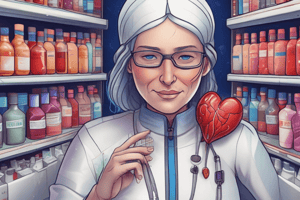Podcast
Questions and Answers
What is the role of statins in cholesterol synthesis?
What is the role of statins in cholesterol synthesis?
- Competitively inhibit HMG-CoA reductase (correct)
- Activate SREBP2 directly
- Enhance cholesterol concentration in cells
- Inhibit LDL receptor gene transcription
What is the consequence of decreased cellular cholesterol concentration?
What is the consequence of decreased cellular cholesterol concentration?
- Inhibition of LDL receptor gene expression
- Inhibition of HMG-CoA reductase
- Activation of SREBP2 (correct)
- Activation of cholesterol synthesis
What is the function of SREBP2 in the context of cholesterol regulation?
What is the function of SREBP2 in the context of cholesterol regulation?
- Inhibits HMG-CoA reductase activity
- Increases cellular cholesterol concentration
- Down-regulates expression of the gene encoding the LDL receptor
- Up-regulates expression of the gene encoding the LDL receptor (correct)
What is the consequence of increased LDL receptor expression?
What is the consequence of increased LDL receptor expression?
What indicates true hepatotoxicity?
What indicates true hepatotoxicity?
Which combination results in additive LDL decreases without significant drug interactions?
Which combination results in additive LDL decreases without significant drug interactions?
What should be closely monitored when co-administering niacin and a statin?
What should be closely monitored when co-administering niacin and a statin?
Which fibrate inhibits both the transport and glucuronidation of statins in the liver?
Which fibrate inhibits both the transport and glucuronidation of statins in the liver?
Which type of statin is preferable in patients taking drugs metabolized by cytochrome P450?
Which type of statin is preferable in patients taking drugs metabolized by cytochrome P450?
What may increase the risk of rhabdomyolysis when combined with certain fibrates?
What may increase the risk of rhabdomyolysis when combined with certain fibrates?
In what type of patients may the combination of niacin and a statin be most useful?
In what type of patients may the combination of niacin and a statin be most useful?
What combination has been reported to be efficacious but may decrease statin clearance?
What combination has been reported to be efficacious but may decrease statin clearance?
What is the effect of statins on LDL-cholesterol concentrations?
What is the effect of statins on LDL-cholesterol concentrations?
What is a potential adverse effect of high-potency statins?
What is a potential adverse effect of high-potency statins?
What is the effect of statins on triglyceride concentrations?
What is the effect of statins on triglyceride concentrations?
What is the mechanism of action of statins?
What is the mechanism of action of statins?
What is the effect of statins on mortality after a myocardial infarction in primary prevention?
What is the effect of statins on mortality after a myocardial infarction in primary prevention?
What is the primary adverse effect of statins?
What is the primary adverse effect of statins?
What is the relationship between statin dose and LDL reduction?
What is the relationship between statin dose and LDL reduction?
What is the effect of statins on high-risk patients with average or below average LDL-cholesterol levels?
What is the effect of statins on high-risk patients with average or below average LDL-cholesterol levels?
What is the effect of statins on HDL-cholesterol concentrations?
What is the effect of statins on HDL-cholesterol concentrations?
What is the evidence for diminished inflammation with statin therapy?
What is the evidence for diminished inflammation with statin therapy?
What may certain patients with a molecular variant of an organic anion transporter be at higher risk of developing?
What may certain patients with a molecular variant of an organic anion transporter be at higher risk of developing?
What is the effect of statins on serum transaminase levels?
What is the effect of statins on serum transaminase levels?
Flashcards are hidden until you start studying
Study Notes
Statins and Their Effects
- Statins have been shown to significantly reduce mortality after a myocardial infarction in both secondary and primary prevention.
- Statin use is associated with a greater absolute risk reduction in secondary prevention due to higher absolute risk of death in this group.
- Statins are effective in reducing cardiovascular disease risk for high-risk patients, even with average or below average LDL-cholesterol levels.
- Statins reduce LDL-cholesterol concentrations by up to about 60%, increase HDL-cholesterol concentrations by 10%, and reduce triglyceride concentrations by up to about 40%.
- The dose–response relationship of statins is nonlinear, with each subsequent doubling of the dose producing an additional 6% LDL reduction.
- Statins have pleiotropic effects, including decreased inflammation, reversal of endothelial dysfunction, decreased thrombosis, and improved stability of atherosclerotic plaques.
- Evidence for diminished inflammation with statin therapy includes decreases in acute-phase reactants such as C-reactive protein.
- Statins are believed to act by the same mechanism, but differences in potency and pharmacokinetic parameters exist among the seven approved statins.
- Statins are generally well tolerated, with the main adverse effect being myopathy and/or myositis with rhabdomyolysis, primarily at high doses of the most potent statins.
- High-potency statins can also cause increases in serum transaminase levels.
- Plasma creatine kinase levels are not useful for routine monitoring of statin-treated patients.
- Certain patients with a molecular variant of an organic anion transporter may be at higher risk of developing statin-induced myopathy.
Studying That Suits You
Use AI to generate personalized quizzes and flashcards to suit your learning preferences.




